We had an early start,
as the check in time for our trip was 7.15am and the lounge was full already
when we arrived. We were the 2nd tour to be called and a very large
number stood up. We were on the ‘small group’ tour, but there proved to be a
lot of these. We were on bus 10 with Tanya (guide) and Paul (driver) and part
of a group of 22 travellers.
Immigration was as we
had been told except for the woman who dealt with me and then John being on the
phone the whole time she dealt with us. Once I heard the sound of her stamp I
could relax. We sat near the back of the bus which was full-sized, so there was
plenty of room.
Tanya then laid out the
plan for the day. We began at Catherine’s Palace, then lunch, the Peterhof
grounds, a hydrofoil back to the city, then the Church of Spilled Blood before
a drive back to the cruise ship. We needed this plan, as we have booked a 2 day
excursion and it was unclear what was on each day.
Catherine’s Palace was specially
opened for us, as it is normally closed on Tuesday. This made for a relatively
uncrowded visit as it was open solely for cruise groups. Outside was a band which played as we lined
up, and they included the music from Swan Lake along with various antics and a
bow at the end.
The Palace had taken 4
years to build with another 4 years to finish the interior. It was built using
criminals and the army hence the quick build speed. The ceilings were canvas
rather than frescos. It was while we were walking through that the fact a lot
was reproduction was revealed. The Palace had been the quarters for the German
army for 28 months during WW2 and they had wrecked the place. It had been
intended that they blow it up with bombs but they did not detonate. However, much
of the roof was missing and items of value from the interior had disappeared.
Some were saved as they had been moved in advance and hidden in the
countryside. Some of the statues in the garden were similarly buried and dug up
after the war. It basically took 20 years to restore the Palace, although there
is still work to do on the bottom floor.
The floors are parquet
and the first thing we had to do was put on protective overshoes to use until
the end of the visit.
The ceilings were also
amazing and it was emphasised that they were painted canvas and not frescos.
Many of the rooms had Delft fireplaces and we were told of the links with the
Netherlands. Peter the Great had gone there to look into boatbuilding when he
was trying to set up a Russian navy and had been very impressed with the canals
in Amsterdam as well as Venice.
We learned a bit about
his daughter Elisabeth. She was known as Elisabeth the spender. She rarely if
ever wore an outfit more than once and had 15000 dresses at the time of her
death.
One room was set up
with porcelain made in the royal factory and is known as the Order design. It
honoured the main order of St George and the bow tied at the end of the table
was for this order.
The highlight is the
Amber room, the one room where no photos are allowed. The initial panels were a
gift to Peter the Great, who had not even opened the boxes before his death.
When his daughter did and saw them, she had the room designed to use them. It
was later wrecked and again we were seeing a replica. This was made using the
best of 11 tonnes of amber sourced for the project. The lesser amber has been
used to made items on sale in the Palace. Our guide did say they were of
excellent quality but very expensive.
When we moved into the
more classical rooms the soft green was something of a relief after all the
gold.
We moved outside to see
the Gallery that Catherine had built to display part of her collection. The
architect was from Scotland and we heard a lot about the work of Cameron. As an
old lady, Catherine would sit near here and admire the gardens. One part was set out in English style while
another part was classical French, with shaped trees and symmetrical designs.
It was here we were
told that the Palace area had originally had about 7 kitchens none of which
were in the Palace itself. Our guide said “there was no smell of cooked cabbage
in the Palace.”
One of the outside
Pavilions was used as an Officers Club during the German occupation and we were
told it is intact. It was built for one of Catherine’s ‘favourites’ with no
expense spared. The floors are mahogany and mother of pearl. It is open for
visitors but in very small groups.
We were then taken to a
souvenir/coffee/toilet area. It was for tourists and took Euros, US$, credit
cards and roubles. It was handy to have a comfort stop and buy water.
We drove to the ‘Hunters
Room’ for lunch. This was ‘interesting’. We were served with borscht (beetroot
soup), then ‘meatballs’ (we couldn’t identify the meat if it existed) with
potato and gerkins and finally a small scoop of ice-cream. There were glasses
of wine on the table and it was pot luck if you had white or red – or could
find someone to swap with. The entertainment was quite fun as it was a family
group playing folk songs. The downside was that the conversations that had
started were terminated, just as we were enjoying talking to Barbara from
Canada and someone from Texas. Overall when rating the programme we had to say
that this lunch was poor.
We then drove through
the countryside, where a number of Russians have their weekend homes, to Peterhof.
This was the seaside residence of Peter the Great and the only royal palace by
the seaside. We were here for the grounds which are famous for their fountains.
They are all gravity driven with water coming from Springs nearby on higher
ground. They are turned on at 11am and off at 6pm through the summer season.
They were amazing and
our guide knew the best spots for us as well. She was excellent at passing on
information in the shade and then maybe sending us on to take photos. She also
gave instructions to the final meeting area for those who wanted to walk a
shorter distance.
We were told that Peter
the Great tried to imitate Versailles in the design. There is a canal down to
the Baltic Sea which both imitates the one in Versailles but also gave him a
route to the palace. He apparently liked water travel and was not a great
horseman, so he could sail across the sea and up the canal to his Summer
Palace. Although a tall man at 6 foot, he didn’t like high ceilings and the
rooms in the palace often had canopy hangings to lower the height.
We started by viewing
the Grand Cascade, the main series of fountains in front of the Palace. Then we
went further around the ground admiring some of the others. The symmetry of the
designs was pointed out to us.
We went back to the
centre of the city by hydrofoil and then walked along the Royal Embankment to re-join
the bus. We then were driven through the now crowded roads to the Church of the
Spilled Blood. It was built on the site where Alexander II was fatally wounded
in March 1881. Funded mainly by the royal family, it took 23 years to build, with
an elaborate shrine where Alexander was killed.
The
Church of the Saviour on the Spilled Blood aspires to be the most Russian
cathedral in St. Petersburg, and is modelled after the beautiful St. Basil's in
Moscow. The other prominent churches in this most European of Russian cities
are modelled after Italian cathedrals. It is not an active church but a museum,
although some services are held here on special occasions. The original
intention had been to use only Russians to build the church but they found they
needed the expertise of Italian masters to make the beautiful mosaic designs.
It was breath-taking to see, with 7700 square metres of mosaics.
After the
Russian Revolution it was ransacked. During WW2 it was a temporary morgue and
after the war it was a storehouse for vegetables. We were told it is surprising
it survived the Stalinist era as he did intend to blow it up. Instead it was
stripped of all valuable church icons, silver etc but the building did remain
intact. The Holy Gates were replaced in 2012 based on pictures from the time.
That was
the end of day one, except for the drive back to the ship. We were back at about
6pm so it was a long day and there was a rush for those going on evening tours
to the ballet etc. We had taken advice and were not booked for the evening so
had a swim to cool down and refresh our tired feet, and had an interesting
evening meal with 2 other couples, including a law lecturer from Australia and a
couple from the US.

 Saint Petersburg, Russian Federation
Saint Petersburg, Russian Federation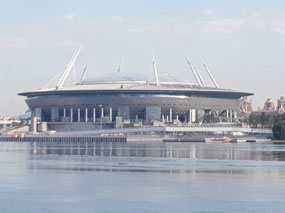
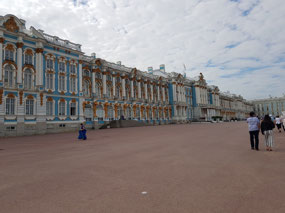
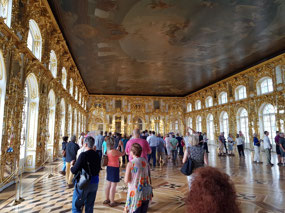
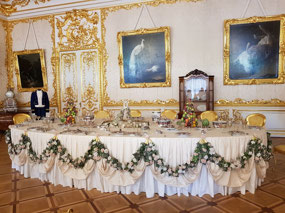
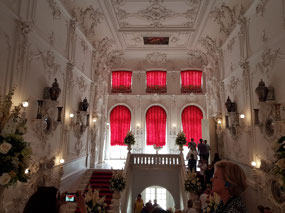
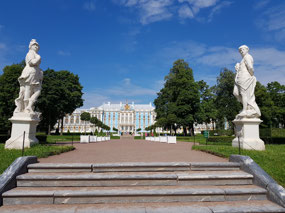
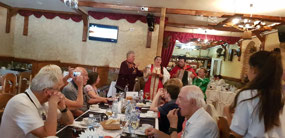

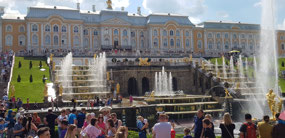
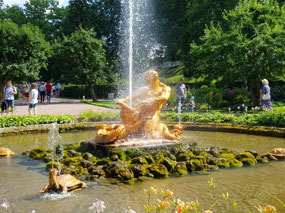
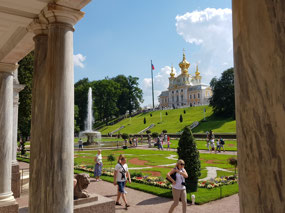
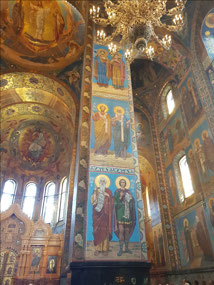
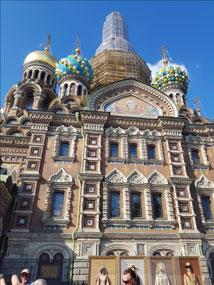
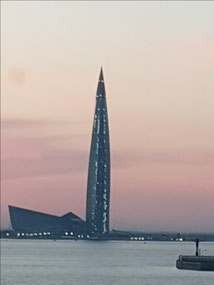









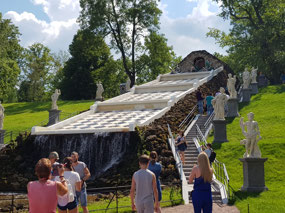
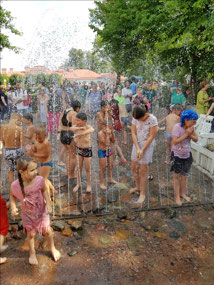
2025-05-22